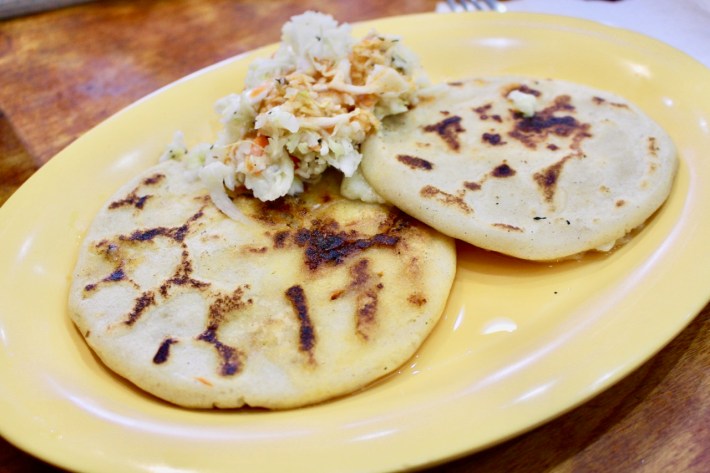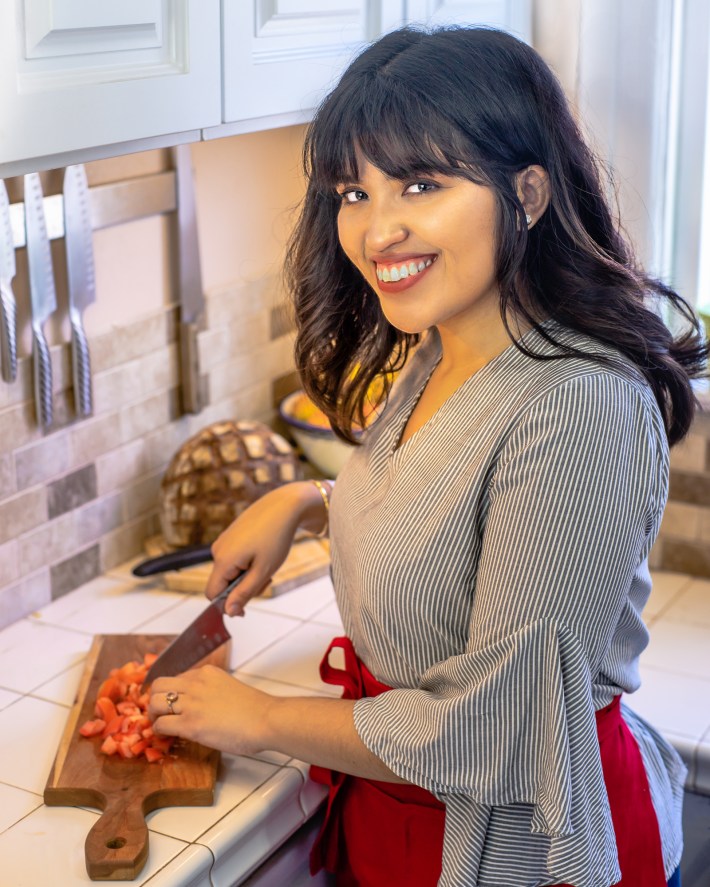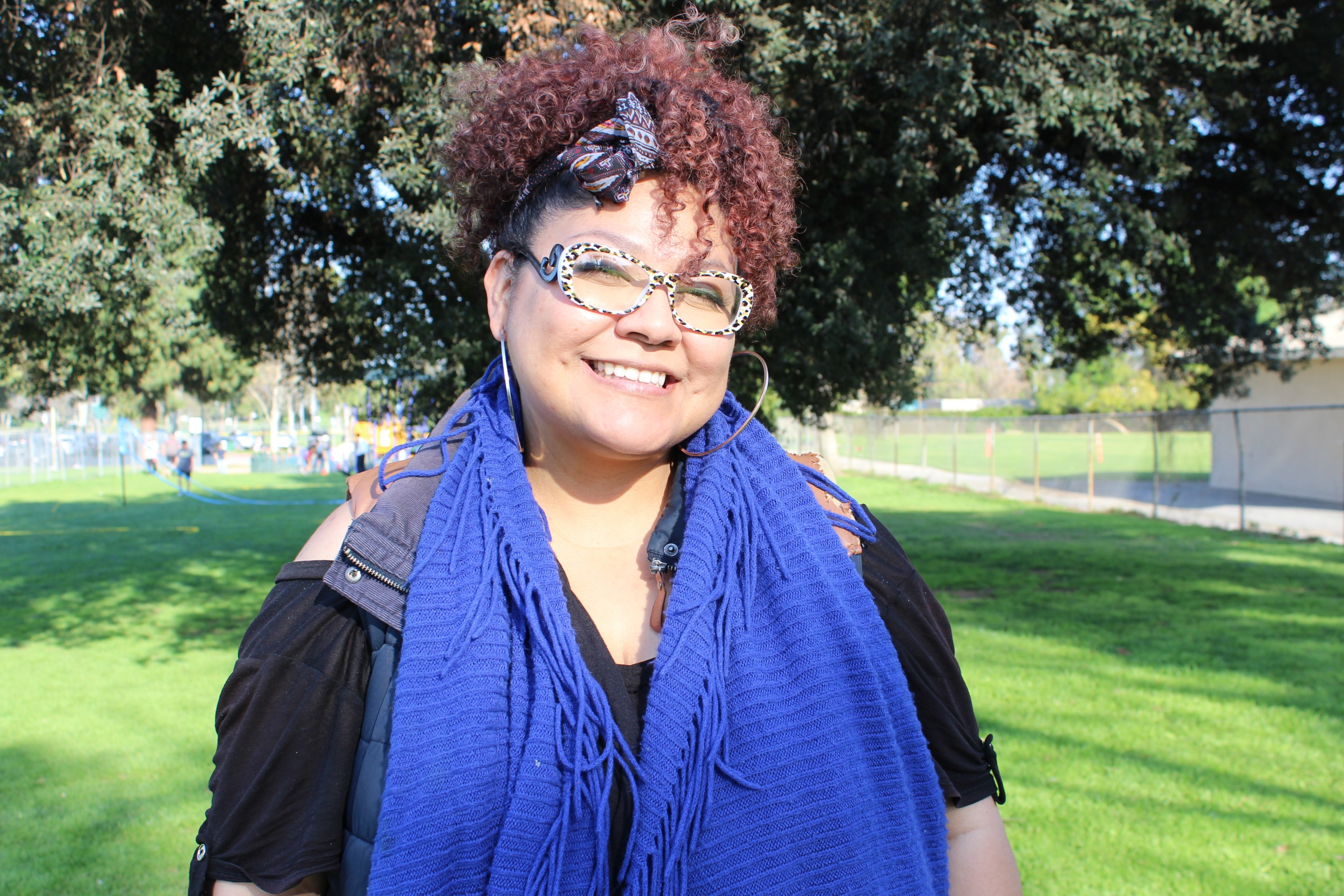[dropcap size=big]O[/dropcap]n Saturday mornings, Salvadoran cumbias blared throughout my family’s tiny apartment in Mid-City as my father shaved his beard in the restroom and my mother cooked a typical Salvadoran breakfast: platanos fritos, frijoles negros, crema, y aguacate, con tortillas hechas a mano. It’s a memory that I still taste to this day. It’s home, or it was.
My parents divorced when I was a child. My sister and I became busy with school and work, and my mother had to work longer hours as a single parent. We still live at home, but sitting down for a traditional Salvadoran meal is not as present anymore because of our conflicting schedules — which is sort of a good thing, but also unfortunate.
In 2015, I was diagnosed with prediabetes. I had to eat less Salvadoran plantain empanadas, which are usually filled with frijoles negros or a vanilla custard; pupusas revueltas stuffed with pork and cheese that gushes out of a pupusa and crisps when fried too long; and casamiento, a popular dish for its “marriage” of black beans and rice.
At 24 years old, I represent the many Latinos and Hispanics who are at greater risk of becoming diabetic, according to the Centers for Disease Control and Prevention. In 2018, the American Diabetes Association found that Hispanics are diagnosed with diabetes at 12.1 percent; black Americans, 12.7 percent; American Indians and Alaskan Natives, 15.1 percent; Asian Americans, 8 percent; and white Americans the lowest at 7.4 percent.
This news has complicated my relationship with Salvadoran food and home. Along the way, our tastes have changed. My mother hardly cooked, and when she would offer to make my sister and me a meal, we would always reply with: “No, we’re on a diet,” or “It’s not healthy,” while secretly craving the taste of sweet fried plantains for breakfast.
“At first it hurt me that you both didn’t want to eat my food anymore,” my mother told me recently in Spanish. “But I got used to it.”
To hear my mother say those words hurt me. How do you give up the staple foods of a cuisine you grew up with and connect so closely to your identity in the name of health? In the search of an answer, I spoke to two Salvadoran women who share concerns similar to my own.

SalviSoul and the Benefits of Roasting or Boiling Plantains Instead of Frying
Karla Vasquez, a food journalist, and historian was 23 years old and just finished a marathon when she was diagnosed with Type 1 diabetes. After meeting with nutritionists, they recommended she stay away from eating carbs or starchy vegetables.

“This was, of course, a huge blow because for a lot of people in the diaspora, food is really a great anchor for a lot of us,” Vasquez said. “We don't really belong here, but we don't have a passport to say we belong somewhere else.”
Vasquez found comfort in Salvadoran food as an immigrant. Her food never questioned her identity; it always made her feel like she was apart of a community. She hopes that health providers would be more willing to learn about different communities’ cuisine and how to support clients who feel the pain of loss when they have to choose to let go of their traditional foods.
The frying technique was not part of Mesoamerican cooking but is a consequence of colonization, Vasquez said.
The body does not produce insulin in Type 1 diabetes and fried foods make the body more insulin resistant. To better understand her own body, Vasquez began playing with Salvadoran recipes. She noticed her sugar would spike tremendously when she ate fried plantains so she began boiling or roasting them. When she checked her blood sugar after doing this, her levels decreased.
The majority of Salvadoran food is healthy. It’s the techniques and practices that make certain foods unhealthy, Vasquez noted. One of the biggest problems, of course, is frying. The frying technique was not part of Mesoamerican cooking but is a consequence of colonization, Vasquez said.
The first pupusas never had cheese. They were traditionally stuffed with beans, squash, squash blossoms and different flower petals that are native to El Salvador.
The Salvadoran dish that most people are aware of are pupusas, a thick tortilla that is usually stuffed with cheese, beans, meat, or loroco, a vine with edible flowers. But the first pupusas never had cheese. They were traditionally stuffed with beans, squash, squash blossoms and different flower petals that are native to El Salvador.
Joya de Cerén is an archaeological site in El Salvador where there once was a pre-Hispanic farming community where the Laguna Caldera volcano erupted in 600 A.D. Archaeologists found food that the community prepared before the volcano erupted and there was never any cheese found, Vasquez said.
“Some Salvis or fans of pupusas kind of get a little upset about that because it's such a big cultural mark to get that little piece of crispy cheese,” Vasquez said.
Although Vasquez decided to not become vegan, she found other solutions to continue eating Salvadoran food. For example, at restaurants, she’ll order rice flour pupusas with beans and loroco.
Many Salvadoran dishes are incomplete without vegetables, she noted. For example, panes con pollo without radish, watercress, cucumbers, tomatoes, and lettuce won’t taste the same. Pupusas without curtido, a pickled cabbage that you spoon over a pupusa, and salsa de tomate is also an incomplete meal.
Vasquez says she supports Salvadorans who are trying to veganize their food. “You can tell when someone is...trying to honor it, if they're respecting it and if they’re doing it in a way that’s dignified,” she said.
The Salvi Vegan and the Veganization of Salvadoran Recipes
Norma Perez, also known as “The Salvi Vegan” on her social media channels, began veganizing Salvadoran dishes after she was diagnosed with osteoarthritis in 2015. She initially worried about what Salvadoran meals she could eat but came to the realization that many were made with vegetables. Some only required a few items to be taken out of recipes.
The first two meals she veganized are her signature dishes panes con pollo and tamales. Perez only took out two ingredients out of her mother’s 13-ingredient recipe to make it vegan.
“If I can get my momma to approve, I got this.”
“The sazón is exactly like my mother’s,” Perez said. “I just took out the animal by-products.”
“Mija, te salieron bien ricos,” Perez's’ mother, who is diabetic, told her after taking a bite. “If I can get my momma to approve, I got this,” she said of her mother’s reaction which inspired her business slogan “It’s mama approved!”
Perez says she wants to make sure people don’t feel like they have to give up everything. As long as your meal has the right sazón, you can still taste the beauty of Salvadoran cuisine.
I have been creating new memories with my mother by visiting different Salvadoran restaurants throughout Los Angeles. We often share the same breakfast meal that she would cook for me as a child.
Giving up Salvadoran cuisine is hard and my pathetic attempts of avoiding it never worked—they still don’t. I make sure I eat a balanced diet and have yearly checkups with my doctor, but I’m still not ready to let go of that special part of who I am.







